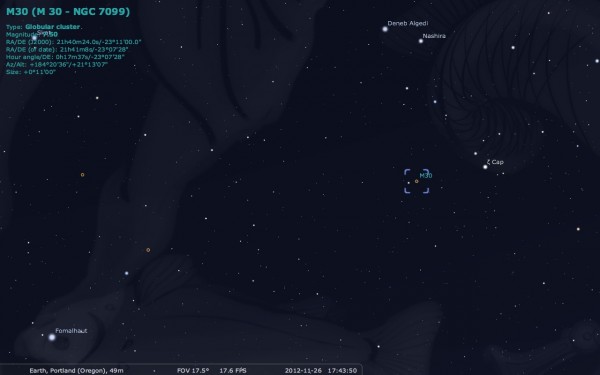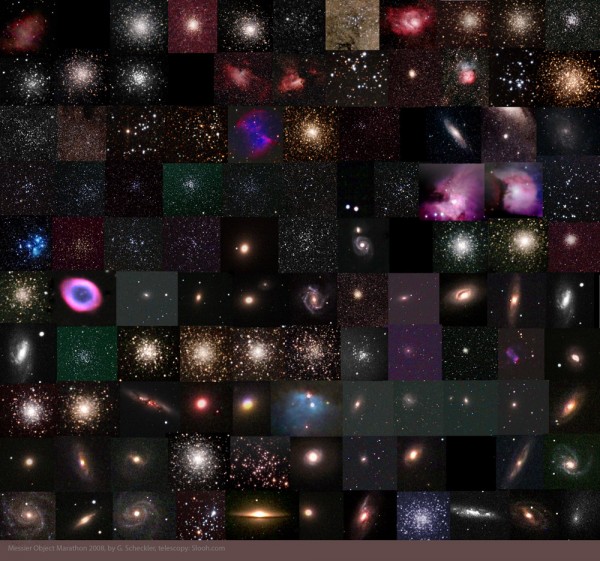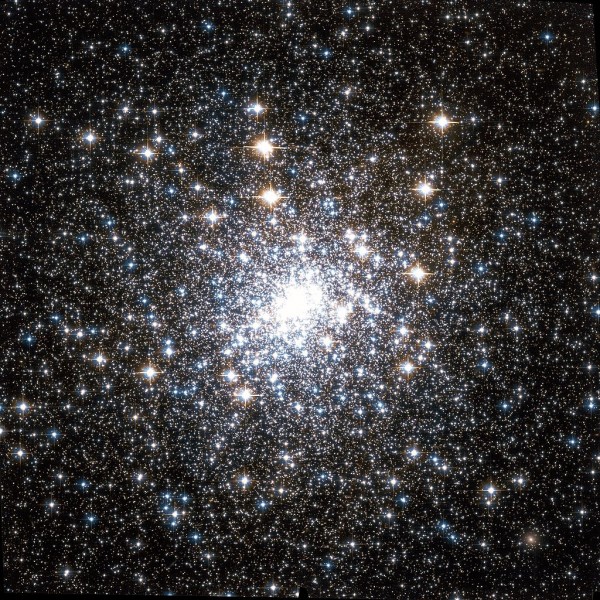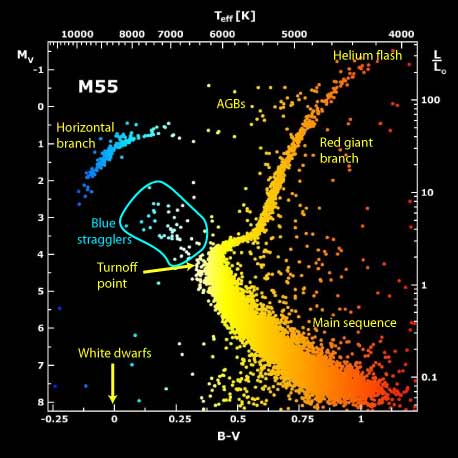"The man's a born straggler... another lucky exception to the rules of natural selection. A million years ago he would've been an easy snack for a saber-toothed tiger." -Carl Hiaasen
Welcome to the latest Messier Monday, where each week we take a look at one of Charles Messier's original catalogue of 110 deep-sky objects that comet-hunters might easily confuse with those transient passers-by in our Solar System.
Quite to the contrary, each of the 110 objects in the Messier catalogue are (semi-)permanent fixtures in our night sky, and all lie well beyond our Solar System's reach. This week, I'd like to take a look at Messier 30, a globular cluster in the Southern Hemisphere that's still visible just after sunset for those of you (like me) in the north. Here's how to get there.

Image credit: Me, using the free software Stellarium, available at http://stellarium.org/.
Depending upon your latitude, the prominent star Fomalhaut -- the 18th brightest in the entire sky -- will be visible above the horizon in the southern part of the sky just after sunset. For those of you down by the tropics or in the southern hemisphere, Fomalhaut will be easy to spot, but for those of you at high northern latitudes like me (I'm at ~46 degrees north), you'll have to look low for a chance to spot it.
But if you can, look higher in the sky and farther to the west; you'll find a collection of naked-eye stars in the constellation Capricorn.

Image credit: Me, using the free software Stellarium, available at http://stellarium.org/.
Just a little bit back towards Fomalhaut, below the "line" of bright stars in Capricorn, you'll find a really ancient globular cluster, Messier 30, whose oldest stars are 12.93 billion years old, or 94% the age of the Universe!
Through a small telescope or large binoculars, it's clearly a compact, star-filled object.

Image credit: Fred Espenak of http://astropixels.com/.
But you don't really get a sense of scale for this object unless you take a closer, more powerful look. Either a modest (6") telescope with an excellent camera,

Image credit: Sergio Eguivar of http://cs.astronomy.com/asy/m/starclusters/488320.aspx.
or a large (12.5") telescope with just a simple camera,

Image credit: user clasley of Astrobin: http://www.astrobin.com/14160/.
reveals the truth: that this is a cluster with a very dense core, and a population of uncharacteristically bright, luminous, blue stars. At nearly 30,000 light-years distant with a mass of about 160,000 suns, Messier 30 is only about 93 light years in diameter, but has a very dense core and, like I said, bright blue stars sprinkled throughout it, but bluer at the core.
Which, as you may know, should not be the case for an object that's practically 13 billion years old!
Why not? Here's the thing: stars come in a wide variety of colors, magnitudes and sizes. When a star cluster -- whether an open cluster within our galaxy or a globular cluster like M30 here -- is created, it produces seven different classes of stars, ranging from the brightest, bluest, hottest and most massive type (O-stars) to the dimmest, reddest, coolest and least massive types (M-stars).
The brightest stars burn through their fuel the fastest, and therefore live the shortest. By time even one billion years goes by, there are no O-or-B stars left; by time 13 billion years have passed, only K-and-M stars will remain.
The remaining stars, when they run out of hydrogen in their core, undergo a variety of well-understood processes, and when we measure the color and magnitudes of the stars in a cluster, the shape that a complete graph of all such stars in the cluster makes gives us an idea of how old that cluster is.
By measuring this "turn-off" temperature, we can determine the age of any star cluster. And that's how we know the age of this particular one, Messier 30. Only, that doesn't explain the blue stars in there.
In fact, these blue stars appear to mess up the Hertzsprung-Russell diagram, because they exist in a place where -- according to the standard picture I just painted for you -- they ought to not exist! And yet, there they are.
So what's going on here? Quite clearly, there are bright, blue stars -- these so-called Blue Stragglers -- that exist in these clusters. A close-up look at the Hubble image from above reveals this without a doubt.
And when I told you it was an even more severe effect in the core, I wasn't lying to you; a visual inspection allows you to verify this for yourself! (At least, it's clearly less yellow, even if you can't easily tell it's more blue.)
What's gone on over here? While a burst of star-formation could have, in theory, been responsible, this is one of the densest globular clusters in the core region ever discovered, with a central density of over 30,000 solar masses per cubic light year! This means the cluster has undergone core collapse, a gravitational process where the center of such a cluster becomes incredibly dense and just keeps increasing the closer you get to the center.
And when this happens, there are two processes that can turn these old, low-mass, doddering stars into bright, short-lived blue ones!
Either, as shown at the top, two low-mass stars can merge, creating a heavier, bluer, hotter star that will burn through its fuel faster. This explanation makes a lot of sense, particularly when the stellar density is very high! Or, as shown at the bottom, a star in a binary system can steal mass from its companion, changing its color and luminosity in the process.
There is some evidence that the collision idea is dominant, but that both processes take place. And that's why, after nearly 13 billion years, Messier 30, one of the oldest globular clusters in the entire Universe, contains more than its share of young-looking, hot blue stars: blue stragglers! So take a look inside; you won't regret it!
- M1, The Crab Nebula: October 22, 2012
- M8, The Lagoon Nebula: November 5, 2012
- M15, An Ancient Globular Cluster: November 12, 2012
- M30, A Straggling Globular Cluster: November 26, 2012
- M45, The Pleiades: October 29, 2012
- M81, Bode’s Galaxy: November 19, 2012
Which one will be next? Join me next Monday for our seventh entry, and let me know what you'd like to see next! There'll be a new Messier object — and a new window into the night sky — waiting for you to discover!
- Log in to post comments









Globular clusters, no matter how we try to pigeon hole them, are going to surprise us. Why they even exist is reason enough. Plus ... being in one !!! A thousand sunsets everyday!
The only way to start the week. Messier Monday!
I <3 globs.
Interesting to see that there's now evidence for the existence of and even the frequency of the two paths to forming blue stragglers. It seems only recently that it was a true mystery with those paths only proposed explanations. The article is dated 2009; only 3 years from publication to entering my consciousness isn't so bad as such things go. :)
Now here is a question. And I preface it with the remark that I really don't know what I am talking about and may be badly mixing up unrelated ideas.
So I defer to whoever understands better.
Why not? Based on:
-this post and
-Ethan recent post http://scienceblogs.com/startswithabang/2012/11/07/every-galaxy-will-ha…
And the discussion in that recent posted end pretty much with a problem between Ethan's hunch and David's measurements.
Ethan's hunch, ", “My hunch is that, as the SFR density drop below a certain threshold, the slope will change, either becoming constant or dropping at a much slower rate, drastically altering (upwards) the total number of stars as we allow t –> infinity. It may take much longer than trillions of years, but it’s hard to envision a self-sustaining star-suppression scenario that last an infinite amount of time without expelling the gas. (And violent relaxation won’t do it.)”
Ethan in that post explained, "Here’s the thing: if you add up all the normal matter in our galaxy — all the protons, neutrons, and electrons — most of it is still neutral hydrogen gas! We’re in no danger of running out anytime soon."
And Wow said, " the premise upon which the claim “95% of the stars in the universe that will ever exist have already been born” is based on faulty reasoning and curve-fitting."
And David Sobral said, "The Universe is certainly not done forming stars, but it is doing it at a rate which is much lower and which has been declining continuously over the last 11 billion years."
David Sobral also suggested, "please make up your sophisticated theoretical model to give me an actual prediction. Things it need to reproduce for me to believe it:
- Evolution of the star-formation rate density
- Evolution of the stellar mass density
If it complies to both and get a completely different result then you should publish it right away in Nature and you’ll solve all problems to do with galaxy formation and evolution."
Ahha! Now here is the thing.
Ethan has a hunch that star formation will continue. Reasonable.
David has measurements that show a 11 Bill years of decline. Reasonable/.
But!! We don't have a good enough theory of evolution of star formations, evolution of galaxies, and evolution of globular cluster; and that relates these three evolutions together in some uber galactic cycle of star formation.
Now what could be consistent with both Ethan's hunch and David's measurements? The measured decline in star has to stop. When? How?
Well maybe it has stopped in the last 1 billion years and with careful measurements we can see it. But if it doesn't stop for another 10 billion years, then we've just got another hunch.
Unless we can see something now, like globular cluster M30's surporising formation of new stars.
Now M30 is as old as globular clusters get at 12.93 billion years old. But it's star formation is current history; it is a mere 30,000 lightyears from Earth. M30 is a globular cluster that is orbiting the MilkyWay!
So here we have a surprise turnaround in star formation. We have a new mechanism. Old sttars, maybe brown dwarfs and white dwarfs that have until now (i.e. over the 11Billion years of David Sobral's research) have not interacted in a way that releases the unspent hydrogen in brown dwarf stars.
But if in globular clusters like M30, those old "dead stars" combine, new stars are born.
So maybe what we need is a comparision of the star formation in old globular clusters over time from 11 billion years ago to now. Yes yes, I know we don't have the james Webb or a super James Webb yet. But I predict that the nearer the old globular cluster; the faster the star formation rate.
Thus a possible mechanism for Ethan's hunch. And a observational measurement challenge for David. Maybe the data is already partially available. I mean ther has to be at least a dozen old M30 like globular clusters already observed some near, some far.
I've said enough. Now I will listen and see if someone who understands better than I tells me that what I say is:
1)possible but we'd need a lot more data and better models of star, glob cluste and galaxy formation and interaction, etc..
2)doesn't solve the problem of David's measurements versus Ethan's hunch because.. of this and that
3) here's a better thought.
So, someone please comment and educate me. thanks.
And David Sobral said, “The Universe is certainly not done forming stars, but it is doing it at a rate which is much lower and which has been declining continuously over the last 11 billion years.”
Which is curve fitting.
Counting the number of hurricanes hitting New York City you have seen a massive reduction recently.
Ergo, there are less than 3% of the number of hurricanes that will ever hit NY left to go.
Wow
I'm not interested in repeating the arguments of the referenced post.
I am asking a new question about this post.
So if you have a reflective thought about my question about M30 type globular cluster; then I'd like to hear it.
I'm interested in your THOUGHTS; not in your ranting..
So, any thoughts ON THE TOPIC of my question about M30 type globular clusters?
Well if your wall-o-text pertained to this:
"Ethan has a hunch that star formation will continue. Reasonable.
David has measurements that show a 11 Bill years of decline. Reasonable/.
But!! We don’t have a good enough theory of evolution of star formations, evolution of galaxies, and evolution of globular cluster"
The problem is that David has something about the past that only talks about the past and then pushes that past into the future for no reason.
You know, curve fitting.
I really don't know how clearer to put it, but you're there saying "So it's red. But what is the colour of it?" repeatedly.
David has done no different than looking at the past 8 months of hurricanes in NY state and then claimed that there is such a huge drop off that if this continued, there are likely only a few hurricanes left.
Despite the elements that allow hurricanes to form and arrive in NY remaining.
How?
By curve fitting and ignoring the method by which the events occur, because the curve doesn't tell you anything about that, merely the count over time.
David's message has nowt to do with M30.
OKThen, a perhaps niggling but important point on nomenclature and classification:
It's not "brown dwarf star", it's just "brown dwarf". Brown dwarfs are by definition sub-stellar objects that never underwent sustained fusion of hydrogen. They did fuse some deuterium, but the rate of such fusion would have dropped off steadily. As would the temperature of the object, very similar to how gas giants and other planets have a steadily decreasing temperature as the heat from their formation is released. Unlike stars which maintain a minimum luminosity over their lifespan due to sustained hydrogen fusion -- and the ones just enough big enough than brown dwarfs to do it, do it the longest, making for a stark contrast.
It's a little confusing, because "red dwarfs" are actually stars, just really small and dim ones, but like I mentioned long-lived.
And "white dwarfs" are the remnants of stars too small to become neutron stars when they die and their cores collapse into a super-dense (but not ridiculous-dense or ludicrouse-dense like neutron stars and black holes) ball of electron-degenerate matter with no fusion occuring.
Black dwarfs are what white dwarfs will become after they finish cooling off, which won't be until the universe is something like 10,000 times older than it already is.
Wow
You are quite determined to beat a dead horse.
I'm happy to leave the discussion of the previous post and comments, which speak for themselves.
So stop and read my question (or NOT) about the surprising star formation (by whatever mechanism) in this 12.9 billion year old but very near globular cluster M30.
If you have any thoughts about the importance of M30 star formation process vis-a-vis my question; well then share your thoughts. That's all.
"The Sonic hedgehog (Shh) signaling (protein) molecule (which) assumes various roles in patterning the central nervous system (CNS) during vertebrate development" is not an issue in this discussion either.
If professional astronomers are too timid to address my question; then I stick by this explanation.
"Stars in globular clusters are generally believed to have all formed at the same time, early in the Galaxy's history 'Blue stragglers' are stars massive enough that they should have evolved into white dwarfs long ago." arXiv:1001.1096
"Globular clusters, which are found in the halo of a galaxy, contain considerably more stars and are much older than the less dense galactic, or open clusters, which are found in the disk." wikipedia
"Surprisingly, we find that the simple correlation with core mass remains by far the strongest predictor of blue straggler population size, even in our joint models. This is despite the fact that the binary fractions themselves strongly anti-correlate with core mass, just as expected in the binary evolution model." arXiv:1210.0542
So the problem is that halo globular clusters should have the oldest stars; but M30 and other old globular clusters are forming new stars blue stragglers and the "core mass remains.. the strongest predictor of blue straggler population size... (and).. binary (stars).. strongly anti-correlate".
Let's believe this data is good rather than bad as the researchers assume. "most appealing, is that observational uncertainties affecting the core binary fractions exceed the intrinsic scatter of the relationship between binary fractions and core mass. This could reconcile the data with the binary evolution model."
But why do they assume the data is bad? Answer, to keep and support the present model, i.e. "reconcile the data with the binary evolution model." Not very bold. In fact, it is stupid to assume that the data is incorrect to save a model.
So what we have is globular clusters migrating from near the galaxy disk to further out near the halo. And as the globular clusters get further out; there stars are older and older (i.e. 11 to 13 billion years old stars). Yes, even though they are in the local vicinity of the local galaxy (e.g. the Milky Way).
But the paradox is that the oldest globular glusters like M30 start forming new stars. " 'Blue stragglers' are stars massive enough that they should have evolved into white dwarfs long ago."
But we don't see white dwarfs; instead we see new star life, i.e. blue stragglers.
Hence instead of locking hydorgen forever in white dwarfs as suggersted by Sobral; we see a possible mechanism for unlocking that hydrogen as hunched by Ethan.
But Ethan remains silent, and Wow becomes indignant. But both refuse to answere my question. Why??
Because research into ancient globular clusters not only offers a mechanism for new star growth (i.e. blue stragglers due to collision Not binary) i.e. " 'Blue stragglers' are stars massive enough that they should have evolved into white dwarfs long ago." But also, ancient globular clusters offer a problem to the standard model of cosmology. So hush, hush, let's not answer that question.
"these 9 GCs (globular clusters) have not been used to study the cosmic age problem in the previous literature...
Globular Cluster... Age(Gyr)
-----B024 ...........15.25 ± 0.75
-----B050........... 16.00 ± 0.30
-----B129........... 15.10 ± 0.70
-----B144D........ 14.36 ± 0.95
-----B239............ 14.50 ± 2.05
-----B260.............14.30 ± 0.50
-----B297D......... 15.18 ± 0.85
-----B383............ 13.99 ± 1.05
Therefore, if the age estimates of these objects are correct, the cosmic age puzzle still remains in the standard cosmology. Moreover, we extend our investigations to the cases of the interacting dark energy models... the interacting DE models still have difficulty to pass the cosmic age test... Therefore, the cosmic age problem still needs to be further investigated in the future work." arXiv:1005.4345
So if you say nothing and pretend that globular clusters and blue stragglers have nothing to do with the issue of new star formation in the distant future (i.e. Every Galaxy will have New Stars for Trillions of Years!); then you will not have to deal with the bigger problem that there are nine old globular clusters that are older that the 13.7 Gyr of the universe.
As an amateur, I am an intellectual without allegiance to any authority (e.g. standard model, religion, philosophy, etc.). I do recognize my limitations in understanding the technical talk of astrophysicsits and would much prefer the explanation of an astronomer.
But, if professional astronomers are too timid to address my question; then I stick by this explanation.